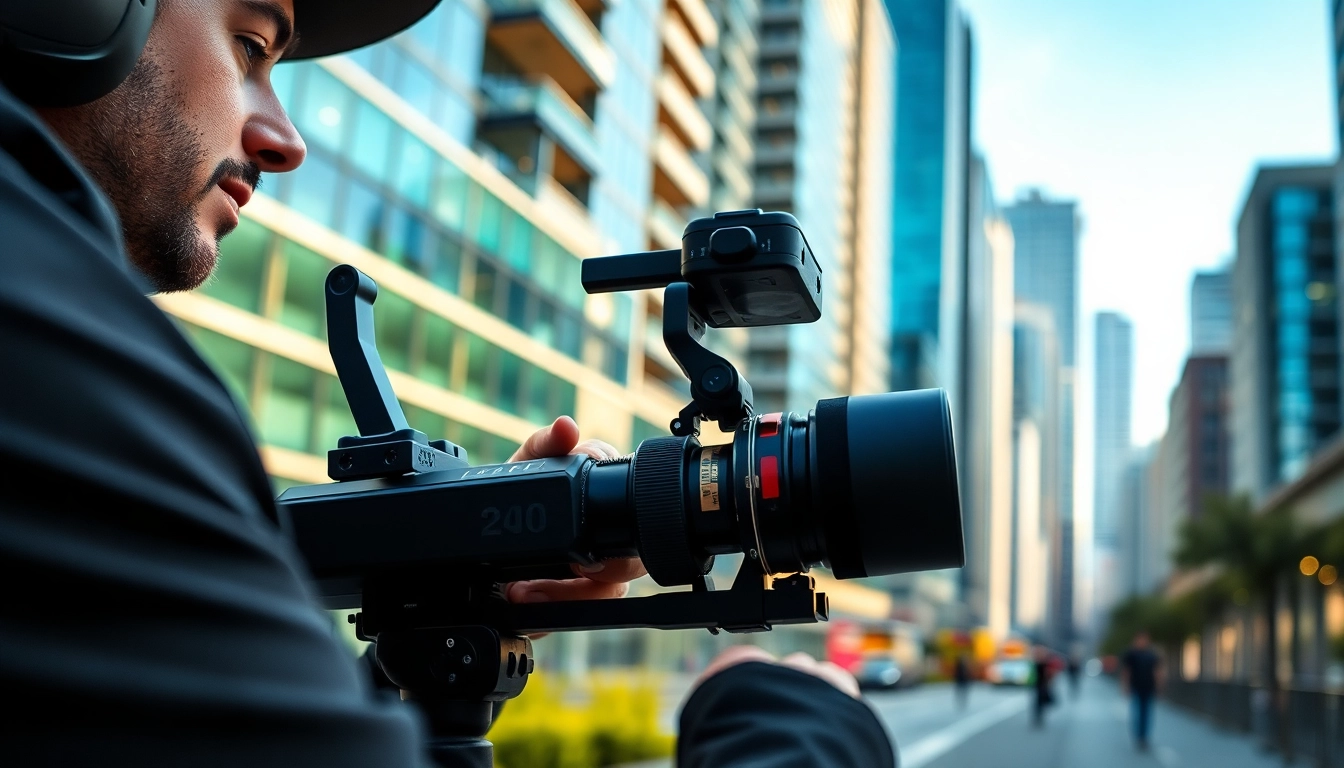Understanding Gimbal Stabilizer Basics
What is a Gimbal Stabilizer?
A gimbal stabilizer is a highly sophisticated device designed to eliminate unwanted camera movements and vibrations, providing smooth and stable footage during filming. This technology has revolutionized the way content is created by enabling filmmakers and videographers to capture professional-grade shots with ease. The gimbal stabilizer achieves its remarkable stabilization by using motors and sensors that adjust the position of the camera in real-time, counteracting any movement caused by shaking hands, walking, or environmental factors.
How Do Gimbal Stabilizers Work?
Gimbal stabilizers function based on the principles of rotational motion. At their core, they consist of three axes: tilt, pan, and roll. Each axis can move independently, allowing the camera to maintain its orientation relative to the horizon. Here’s a more detailed breakdown:
- Tilt Axis: This controls the up-and-down movement of the camera, helping to stabilize vertical angles.
- Pan Axis: This axis controls the left-to-right movement, stabilizing the camera while following moving subjects.
- Roll Axis: This removes any tilting motion that may occur, keeping the frame level.
By integrating accelerometers and gyroscopes, gimbal stabilizers continuously assess the camera’s position and make rapid adjustments to counteract unwanted motion, resulting in smooth and stable footage.
Types of Gimbal Stabilizers: An Overview
Gimbal stabilizers come in various types, each designed to cater to specific needs and camera systems. Here’s an overview of the major types:
- Handheld Gimbals: Ideal for DSLR and mirrorless cameras, these are compact and allow for easy maneuvering, making them perfect for dynamic filming scenarios.
- Smartphone Gimbals: These lightweight gimbals are specifically designed for smartphones, providing an accessible option for casual videographers and social media creators.
- Drone Gimbals: Integrated into drones, these are engineered to stabilize cameras in mid-air, achieving smooth aerial shots.
- Studio Gimbals: Larger and heavier, these stabilize professional cameras for studio shoots, primarily in controlled environments.
Setting Up Your Gimbal Stabilizer
Essential Assembly Tips for Gimbal Stabilizers
Setting up a gimbal stabilizer correctly is crucial for achieving optimal performance. Here are some essential assembly tips:
- Read the Manual: Always start by thoroughly reading the manufacturer’s manual to understand specific assembly requirements.
- Check Compatibility: Ensure that your camera is compatible with the gimbal in terms of weight and size.
- Attach the Camera: Securely mount your camera onto the gimbal, tightening screws to prevent movement during operation.
- Connect Power Sources: If applicable, ensure that batteries are charged and properly connected to power the gimbal’s motors.
- Calibrate: Perform calibration as per the manufacturer’s instructions to ensure the gimbal is balanced for optimal performance.
Balancing Your Gimbal Stabilizer Properly
Balancing a gimbal stabilizer is essential for it to function effectively. A well-balanced gimbal reduces strain on the motors, prevents overheating, and extends battery life. Here’s how to achieve proper balance:
- Adjust the Tilt Axis: Hold your gimbal horizontally and adjust the tilt arm until the camera is level.
- Adjust the Roll Axis: While holding the gimbal, tilt it sideways. If the camera shifts, make adjustments until it stays still in the desired position.
- Adjust the Pan Axis: With all other axes balanced, test the gimbal by placing it on its base. If the camera tilts or rotates, adjust the counterweight until it remains steady.
Connecting Cameras and Accessories to Your Gimbal Stabilizer
After balancing your gimbal, connecting your camera and accessories properly enhances functionality. Follow these steps:
- Ensure Power is On: Check that both the gimbal and camera are powered on.
- Connection Cables: Use appropriate connection cables for remote control features, ensuring a secure fit.
- Attach External Microphones: If using audio recording devices, securely attach them to the gimbal or camera as necessary.
- Insert Memory Cards: Ensure the camera has sufficient storage with memory cards inserted correctly.
Mastering Gimbal Stabilizer Techniques for Filming
Cinematic Movements with Gimbal Stabilizers
Gimbals enable filmmakers to achieve a variety of cinematic movements that enhance storytelling. Here are some popular techniques:
- Crane Shot: Mimics the motion of a crane, allowing upward or downward movement while maintaining stability.
- Dolly Shot: Smoothly moves towards or away from the subject without the usual sudden jolts.
- Walking Shot: Maintains stability while capturing dynamic shots on the move, giving an immersive feel.
- Revealing Shot: Gradually showcases the full frame of a scene, building suspense and interest.
Best Practices for Smooth Footage with Gimbal Stabilizers
To ensure smooth and professional-looking footage, here are some best practices:
- Slow Movements: Make slow, deliberate movements to maintain steady footage.
- Use of Footwear: Wear soft-soled shoes to minimize noise and vibrations during shooting.
- Practice Panning: Smoothly pan your gimbal with a gentle wrist motion for the best tracking shots.
- Focus on Framing: Prioritize framing your shots correctly; good composition minimizes post-production corrections.
Common Mistakes to Avoid with Your Gimbal Stabilizer
Even experienced users can fall prey to common mistakes. Here are some pitfalls to avoid:
- Improper Balancing: Skipping the balancing process can lead to shaky footage and unnecessary strain on the motors.
- Neglecting Battery Life: Always check battery levels before shooting to avoid mid-session failures.
- Overusing the Gimbal: Avoid relying solely on the gimbal; combine it with traditional filming techniques for best effects.
- Ignoring Settings: Make sure camera settings (like frame rate and resolution) are optimized for your shot.
Advanced Gimbal Stabilizer Techniques
Dynamic Shots: Moving with Your Gimbal Stabilizer
Advanced users can leverage their gimbal stabilizers for dynamic shots by incorporating movement into their filming practices. Here’s how you can master moving shots:
- Tracking Subjects: Focus on following a subject smoothly while they are in motion, maintaining even steady tracking.
- Creating Lateral Movements: Move laterally around the subject while keeping the frame stable to add depth.
- Using a Walking Method: Train your walking technique to match the gimbal’s movement, ensuring a stable and fluid action.
Creative Angles and Perspectives Using a Gimbal Stabilizer
Exploring varied filming angles enhances production value. Implement these creative techniques:
- Low Angle Shots: Capture dramatic low angles that emphasize height and stature.
- Looking Up Shots: Shoot from ground level looking up, creating engaging perspectives on subjects.
- Bird’s Eye Views: If your gimbal stabilizer supports aerial setups, capture unique overhead shots.
Integration of Gimbal Stabilizer Techniques in Storytelling
Effective storytelling can be significantly enhanced through the use of gimbals. Here’s how to integrate gimbal techniques into your narrative:
- Establish Context: Use wide, revealing shots to set the scene before zooming in on key details.
- Visual Flow: Maintain a visual continuity by smoothly transitioning between shots, connecting different scenes effortlessly.
- Emphasizing Emotion: Use close-ups and intimate movements to evoke specific feelings within your audience.
Troubleshooting Your Gimbal Stabilizer
Identifying Common Issues with Gimbal Stabilizers
Despite their convenience, gimbal stabilizers can encounter issues that may disrupt shooting. Here are common problems to look out for:
- Unstable Footage: This may occur due to improper balancing or poor calibration.
- No Response: Gimbal not responding can be a result of low battery or connections being loose.
- Motor Overheating: Extended use without breaks may lead to overheating; always allow the gimbal to cool down when needed.
Effective Solutions for Gimbal Stabilizer Problems
When issues arise, these solutions can help restore function:
- Re-Balance: If footage is unstable, go through the balancing process again to ensure proper weight distribution.
- Recharge Batteries: Regularly maintain batteries and replace them if they no longer hold a charge.
- Check Connections: Ensure all connections are secure and free of dust, which can interfere with performance.
Maintenance Tips for Longevity of Your Gimbal Stabilizer
Proper maintenance extends the lifespan of your gimbal stabilizer. Follow these tips to ensure long-term use:
- Keep it Clean: Regularly wipe the gimbal’s surface and sensors with a dry microfiber cloth to remove dust and grime.
- Store Properly: Use cases designed for gimbals during transport to avoid physical damage.
- Regular Checks: Periodically check mechanical components for wear and tear, and service as necessary.



